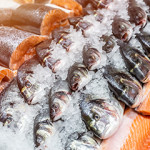Pacific Ocean Aquafarms launching offshore yellowtail farm project in California

Editor's Note: A previous version of this story incorrectly linked the new permit application filed by Pacific Ocean AquaFarms for a yellowtail farm in California with the former Catalina Sea Ranch farm, located about six miles off the coast of Huntington Beach, California. While Pacific Ocean AquaFarms partner Pacific6 owns the Catalina Sea Ranch assets, the new project is separate from that facility and location.
Long Beach, California, U.S.A.-based Pacific6 has filed a permit application to build an offshore yellowtail farm four miles off the coast of California.
Pacific6 is the same group that purchased the assets of Catalina Sea Ranch, the only permitted aquaculture facility in U.S. federal waters, in May 2020. It has since formed a collaborative group with Hubbs-SeaWorld Research Institute (HSWRI), a San Diego, California-based nonprofit research institute that works in cooperation with, but is independent of, SeaWorld Parks & Entertainment.
On Wednesday, 9 September, that collaboration, named Pacific Ocean AquaFarms (POA), filed for a permit to operate a farm growing California yellowtail (Seriola dorsalis), with an initial annual capacity of 1,000 metric tons (MT), and eventually scaling up to 5,000 MT of annual production “as it proves its environmental and economic sustainability,” according to a POA press release. If approved, construction is expected to take one year, and initial grow-out will take an additional two years.
“We see this as a game changer for the U.S., which today imports the vast majority of its seafood, half of which is farmed,” Pacific6 Founding Partner Robert Gordon said. “Our project will show how aquaculture, subject to our nation’s stringent environmental and food safety standards, will be done right.”
The first – and most daunting step – for POA will be to seek permits from the bevy of federal and state agencies that must approve of the project before it can commence operations. Working with NOAA as the lead agency in the permitting process, it must collect a protected resources approval from NOAA, a navigable waters permit from the U.S. Army Corps of Engineers, an aids to navigation permit from the U.S. Coast Guard, a national pollutant discharge elimination system permit from the U.S. Environmental Protection Agency, an aquaculture registration and oversight permit from the California Department of Fish and Wildlife, and an approval of consistency with the Coastal Act review from the California Coastal Commission. It then must obtain a final review approval under the National Environmental Policy Act from NOAA. POA said it anticipates the process to take 18 to 24 months.
In a summary document circulated by the company, POA said it wants its project to pave the way for more extensive use of the U.S. exclusive economic zone for ocean mariculture.
“With the immense size of the U.S. EEZ, our advanced ocean science and technology, and our exceptionally high standards for food production, the U.S. has the untapped potential, and the need, to lead the world in developing responsible, sustainable marine aquaculture,” it said. “Pacific Ocean AquaFarms is committed to developing a marine seafood farm that will serve as a model for responsible offshore aquaculture – producing health food, creating, jobs, and supporting working waterfronts for generations to come – all while vigorously protecting the ocean’s natural resources.”
The company said it expected to generate at least USD 50 million (EUR 42.4 million) in annual sales, USD 100 million (EUR 84.8 million) in annual spending, and 300 permanent jobs.
“Other significant benefits from the project, including economic development and job creation, preserving and invigorating working waterfronts, creating synergies with the commercial fishing industry, catalyzing a new domestic industry, offsetting the national trade deficit, enhancing domestic food security, reducing seafood’s carbon footprint and informing improvements to global food production,” it said.
In the document, POA stressed the benefits of the location of the farm, which is four miles off the coast of southern California, “positioned in deep, clean, temperate water with good current, away from critical habitats; sited to minimize conflicts with commercial and recreational fishing, shipping, and military activities; located outside the coastal zone and within natural range for the species; close to robust consumer markets; and utilizing existing commercial fishing infrastructure.”
The operations will be helped by HSWRI’s science-based consulting services – particularly in the fields of ecology, physiology, and acoustics, HSWRI President and CEO Donald Kent said.
“Aquaculture is at a crucial inflection point. Scientific and technical advances have addressed past concerns about negative impacts. And, as the single most sustainable and fastest-growing food production sector in the world, aquaculture must grow in the U.S,” Kent said. “The single greatest obstacle to date has been the lack of a defined path for permitting through the existing extensive regulatory system. Working with NOAA as the lead agency for environmental review, our efforts will help delineate that pathway. Being the first is difficult, but making sure it is done right is the goal we share with the regulatory agencies.”
Despite the challenging path forward, the project may be helped by a recent executive order issued by U.S. President Donald Trump that directed the U.S. government to prioritize aquaculture and simplify the permitting process.
“We are committed to seeing this through,” Kent said. “It is really a moral imperative to demonstrate a new way to help feed a hungry world with healthy, locally grown seafood.”
With capitalization of more than USD 100 million (EUR 84.8 million) and a group of six founding partners that includes is John Molina, formerly the chief financial officer of Molina Healthcare, a Fortune 200 organization, the partnership is “committed … to provid[ing] leadership and support in demonstrating the viability of ocean-based aquaculture through best practices, responsible stewardship, and diligent consideration for the environment.”
“Aquaculture is an essential food solution, and POA’s vision is simple. Do it here. Do it right. Do it now," Gordon said.
Photo courtesy of Pacific Ocean AquaFarms






Share